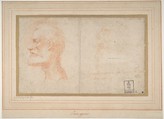Head of a Bearded Man in Profile to Left, possibly the Portrait of the Poet Giorgio Anselmi (ca. 1459-1528), with Faint Sketch of a Skull-like Head
Parmigianino (Girolamo Francesco Maria Mazzola) Italian
Not on view
Portrait drawings by Parmigianino (other than self-portraits) are quite rare. The left half of this delicately drawn sheet is apparently a portrait of the Parmese statesman and humanist Giorgio Anselmi 'nepote' ('nephew'). Although Anselmi was celebrated in his day as a writer of odes and love poetry in the classical Latin tradition, he has all but been forgotten today. The inscription, which is certainly in Parmigianino's hand as the hue of the red chalk is exactly the same as in the drawings, may establish the poet's precise death date, 21 September 1530. The slight sketch of the skull on the right half of the sheet undoubtedly constitutes a 'memento mori,' and the inscription below may well refer to the poet's date of death, although this contradicts Ireneo Affò's late eighteenth-century account of Anselmi's demise in the great plague that swept through Parma in 1528 (Memorie di scrittori e letterari parmigiani, Parma, 1791; Quattrucci 1961). Anselmi is thought to have been born before 1459, although this is not documented. Parmigianino's drawing belongs stylistically to around 1530-5, and it may well have been preparatory for an engraved illustration accompanying a posthumous printing of one of Anselmi's literary works during that decade.
(Carmen C. Bambach)
Due to rights restrictions, this image cannot be enlarged, viewed at full screen, or downloaded.
This artwork is meant to be viewed from right to left. Scroll left to view more.





